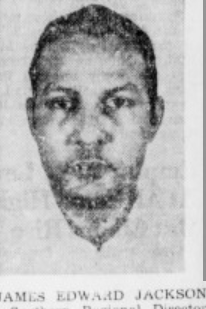Sausalito News, 23 August 1951 page 3
http://cdnc.ucr.edu/cgi-bin/cdnc?a=d&d=SN19510823.2.6&e=——-en–20–1–txt-txIN——-#
THESE COMMIE LEADERS ARE BEING SOUGHT BY THE FBI
JAMES EDWARD JACKSON Jr.. Southern Regional Director of the Communist party, USA age 36, born November 29, 1914. Richmond, Virginia; height 5 feet 6½ inches; weight, 160 pounds; build, medium; hair, black, curly, bald in front; eyes, brown; race. Negro: nationality, American; scars and marks, small star scar outer corner of left eye. Jackson received a Doctors Degree at Howard University of Pharmacy in Washington, D. C. He has resided in Richmond, Virginia; Washington, D. C.: Arlington. Virginia and in Birmingham, Alabama. He has been employed as a druggist, labor organizer, writer, and lecturer. He is described as well-groomed and neat in appearance. He sometimes wears a mustache. Any person having information .which may assist in locating James Edward Jackson, Jr , is requested to immediately notify the nearest FBI office.
Then, this obituary from the New York Times:
James Jackson, Rights Activist, Dies at 92
By DENNIS HEVESI
James E. Jackson Jr., a civil rights activist, former official of the American Communist Party and defendant in a case that led the Supreme Court to rule that the Smith Act of 1940 did not prohibit the advocacy of violent revolution, died on Saturday in Manhattan. He was 92 and lived in Brooklyn.
The death was announced by his daughter Harriet Jackson.
Mr. Jackson was one of 21 Communist Party members who were indicted in 1951, at the height of the McCarthy era, for, among other things, teaching classes on violent revolution. The case was front-page news around the country.
He was one of six of those defendants whose conspiracy convictions under the Smith Act were unanimously reversed by a federal appeals court in 1958. The reversal was based on Yates v. United States, a 1957 Supreme Court ruling in the overall case that the mere teaching or advocacy of an overthrow of the government did not constitute a “call to action.”
Most of the 21 defendants had been convicted and imprisoned. But Mr. Jackson and five others went into hiding — “roaming the country like during the underground railroad,” his wife, Esther Cooper Jackson, said on Wednesday. Mr. Jackson did not see his family until 1956, when he surrendered and, with his colleagues, was convicted of conspiracy.
The next year, with the Red Scare somewhat subsiding, the Supreme Court issued its Yates v. United States decision, stating that the Smith Act “requires more than the teaching and advocacy of an abstract doctrine that the government should be overthrown by force and violence.” The appeals court overturned the convictions, ruling that the government had failed to prove that the defendants had urged people to “do something” rather than “believe in something.”
The Yates decision signaled a shift toward a legal principle that the advocacy of illegal conduct is usually constitutionally protected, said Eugene Volokh, a law professor and First Amendment scholar at the University of California, Los Angeles. “You can say, ‘We think abortionists should be murdered,’ and that is usually protected,” Professor Volokh said.
Mr. Jackson held important positions in the Communist Party. In the early 1960s, he was editor of The Worker, the successor to the party’s newspaper, The Daily Worker. Later, he was international affairs secretary and national educational director. He joined the party in 1947, and in 1952 became its Southern secretary and a staunch advocate of civil rights.
“For 300 years as bondsmen and some 93 years as freemen, under slaver’s whip and Jim Crow law,” Mr. Jackson wrote in The Daily Worker in 1958, “Negro Americans have yielded up their labor and expended their lives for the upbuilding of this country in yet unfathomed measure.”
James Edward Jackson Jr. was born in Richmond, Va., on Nov. 29, 1914, the son of James and Clara Kersey Jackson. His father was a pharmacist. The family lived in a part of Richmond called Jackson Ward, a section set aside for blacks. In 1931, when he was 16, Mr. Jackson entered Virginia Union University. He graduated three years later with a degree in chemistry. In 1937, he received a degree in pharmacy from Howard University. But in his last year at Howard, he helped start the Southern Negro Youth Congress, which organized strikes by tobacco workers, mostly black women, who were paid $5 a week. A union representing 5,000 tobacco workers soon gained recognition.
“Historians view the Southern Negro Youth Congress as the predecessor of the Student Nonviolent Coordinating Committee,” a major civil rights force in the 1960s, said Michael Nash, director of the Tamiment Library at New York University, where Mr. Jackson’s papers are stored.
In the late 1930s, Mr. Jackson was part of a team contributing research to “An American Dilemma,” the groundbreaking 1944 study by Gunnar Myrdal, which raised consciousness about race relations. Mr. Jackson’s work took him to Fisk University in Nashville, where he met another researcher, Esther Cooper. They married in 1941.
Besides his wife and his daughter Harriet, Mr. Jackson is survived by another daughter, Kathryn Jackson; a grandson; and two great-grandsons.
In World War II, Mr. Jackson served in an engineer battalion, building the Burma Road. It was an all-black unit led by white officers.
